Without a doubt, tire questions are among the most common we get around the DPP offices. Whether it’s a recommended tire for ride quality or longevity, the perfect trail tire, or the best tire size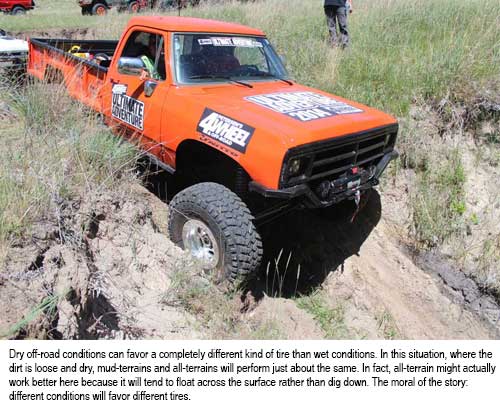
for a certain lift, we field a bunch of tire questions every day. Though these questions would seem easy to answer, in reality there are a lot of different factors to consider. The best answer to these questions without getting a lot of additional information is “It depends,” but that only leads to more questions. While we love chatting with our customers on the phone and are always happy to bench-race with them, we decided to put a few thoughts down here on virtual paper that will maybe help guide people in search of the perfect number for their own application.
The Factors Involved
As we mentioned, one of the reasons that it’s hard to answer tire questions is that the answers depend on a wide variety of factors. Some of them will seem obvious, while others might be surprising. Here’s a list of the most common ones and why:
Tire Load Rating and Construction – Among the most important things to consider, weight includes not just the weight of the truck but also whatever it’s hauling. Weight is a very important part of choosing the right tire. Just like our trucks, tires are rated to carry a certain amount of weight, but load ratings can vary a bunch among different tires of the same size. Diesel trucks tend to be heavy, and owners often work their trucks. A truck that’s used primarily for drag racing and doesn’t do any towing can get away with lightly rated tires, while workhorses that only move with heavy loads attached to them should always have tire load ratings that match what they’re hauling. For most of us, that means load range E or higher. Tire construction is especially important for off-road use. Radial tires can have very thin sidewalls that are susceptible to punctures, so picking tires with extra plies in the sidewalls is important when venturing off the pavement.
Pavement vs. Off-Road Use – While all of us wish that we could spend our days four-wheeling, unless it’s a dedicated toy the reality is that our trucks spend the vast majority of their time on the pavement. Be honest with yourself when it comes to how much time you spend with your truck on and off the pavement and what your performance expectations are under those circumstances.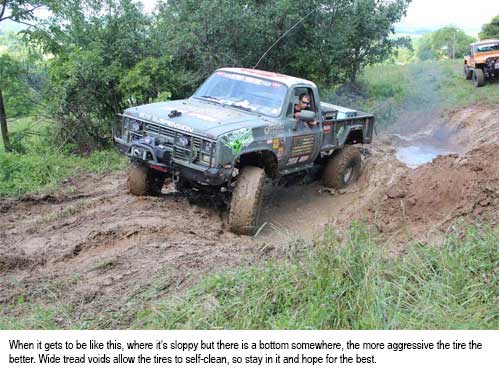
Weather Conditions – If you live in the deserts of the Southwest, chances are you really don’t care about how well your tires perform in the snow, and their wet weather performance is probably not as important as their ability to hold up in the heat. Conversely, you people that live up close to that Northern border where folks on the other side say “Eh” a lot consider snow performance rather important. Tires are rated for snow performance, and generally speaking, the higher the load rating, the better a tire is at handling heat.
Off-Road Conditions – In some parts of the country, mud rules the roost and is the only type of terrain you are likely to encounter off of the pavement. In other parts of the country, slippery rocks and slime-covered roots are the norm. In still other places, it’s bone dry most of the time but the rocks are sharp enough to shred a tire to bits. Each of these conditions will favor a different kind of tire. Locals usually know best what works in their areas, so it’s always good to ask around if you’re new to the area.
Noise Tolerance – Though we’ve met surprisingly loud all-season tires and surprisingly quiet mud-terrain tires, generally speaking, the more aggressive the tire, the louder it is going to be. Some guys want the look of knobby tires and don’t care about how much noise they make, while others live in fear of displeasing their significant other who gets annoyed with any noise that interferes with her enjoyment of Beyonce’s latest hit. Dumb young guys think the radial-engine-like howl is cool, while grouchy old guys just want peace and quiet. If noise is a concern, then you should probably stay away from aggressive tires.
Driving Style – If you often find yourself channeling Mario Andretti at the Indy 500 and pitch your truck into corners like it’s a Ferrari, then an aggressive mud tire probably isn’t a good choice. While you’d probably be better off leaving the diesel truck at home and taking a sports car when you want to get your Parnelli Jones on, remember that different tire styles will have a big impact on high-speed, cornering, and braking performance. If you’re towing, expect those effects to be even more pronounced.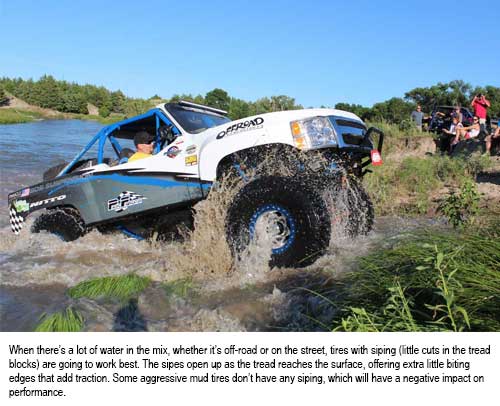
Speed – Along with weight, speed is perhaps the single biggest factor in tire longevity, the higher the speed, the more heat that is generated along with higher cornering forces. Though really more appropriate to talk about with performance car applications, running up and down the highway at 80-plus mph all day long is a lot different from farm and ranch roads under 15 mph.
Size – Though we’ll get into more detail about tire size, tire selection does vary quite a bit depending on the desired tire size as well as wheel diameter. The sky is the limit if you’re talking about a 35×12.50-17 (or 315/70-R17), but bump the wheel diameter to an 18 and selection drops significantly. Also remember that tire selection drops a lot above 35 inches in diameter, and then a whole bunch more above 37 inches in diameter. Those 18- or 19-inch rims may look pretty sweet until you want to put a different tire on them, or even simply replace that tire you cut in the middle of nowhere and then limped into the nearest backwoods town.
All-Season vs. All-Terrain vs. Mud-Terrain
While there are many, many different tire choices out there, they basically fall into one of these three categories. While mud-terrain tires are without a doubt the sexiest of the three choices, they may not be the best one for your application. In fact, all three types of tires have their place.
All-season tires are basically all of those lame street tread tires you see on stock trucks. While they certainly don’t do anything for looks, they do have their advantages. They usually have an 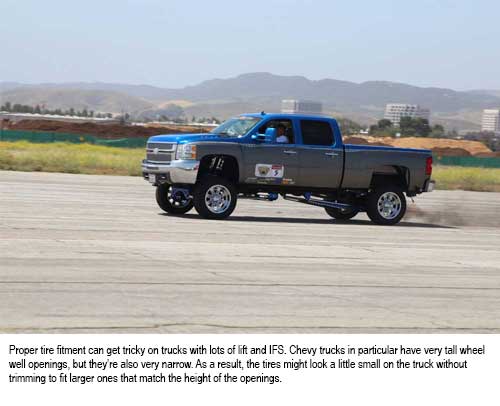 appropriate load rating for the truck, they’re quiet, they tend to hold their balance, and they often (but not always) wear like iron. Best suited for running up and down the highway, about the only adverse condition all-season tires to well in is rain thanks to their heavy siping. Once off the pavement, however, they bring the suck. Aside from not offering much traction in general, they typically pack up with mud instantly and turn into a slick. Ever seen a truck get stuck on wet grass? They’re usually wearing all-season tires when they do. Though all-season tires are often available in a size or two over your truck’s stock tire size (making them a reasonable choice for pairing with a leveling kit), sizes get limited above a 285. And don’t let names fool you: even if it says all-terrain on the sidewall, if the tread pattern looks perfectly at home on a car, it’s actually an all-season. Other than getting flak from your buddies about having a pa-paw truck, there is nothing wrong with a truck on all-season tires.
appropriate load rating for the truck, they’re quiet, they tend to hold their balance, and they often (but not always) wear like iron. Best suited for running up and down the highway, about the only adverse condition all-season tires to well in is rain thanks to their heavy siping. Once off the pavement, however, they bring the suck. Aside from not offering much traction in general, they typically pack up with mud instantly and turn into a slick. Ever seen a truck get stuck on wet grass? They’re usually wearing all-season tires when they do. Though all-season tires are often available in a size or two over your truck’s stock tire size (making them a reasonable choice for pairing with a leveling kit), sizes get limited above a 285. And don’t let names fool you: even if it says all-terrain on the sidewall, if the tread pattern looks perfectly at home on a car, it’s actually an all-season. Other than getting flak from your buddies about having a pa-paw truck, there is nothing wrong with a truck on all-season tires.
The next step up in the tire spectrum is also where you start getting some street and trail cred. Truth be told, all-terrains are really the best choice for about 90-percent of us. Though we’d like to think we spend most of our time on the trail, the fact of the matter is that our trucks spend far more time on the pavement hauling our butts to and from work, the grocery store, soccer practice, and so on. An all-terrain tire strikes a nice balance between on-road manners and off-road capability. They are usually only slightly louder than a street tire, yet they offer dramatically better performance off-road. All-terrains also look a whole lot better than stock tires by offering a more aggressive attitude to any vehicle, and they are available in a wide range of sizes that are significantly larger than stock. Modern all-terrains take the aggressive look one step further with aggressive-looking profiles that mimic even more aggressive tread designs on mud-terrains. There’s a strong chance you can find an appropriately size all-terrain tire for any truck that’s lifted up to about 6 inches, and sometimes even taller lifts depending on the size. All-terrains typically offer excellent traction in a wide variety of conditions, including wet conditions and snow (due to siping), but their one Achille’s heel is typically mud. The attributes that give an all-terrain good street 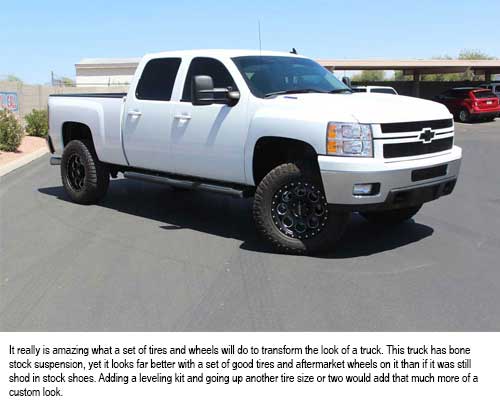 manners (milder tread block shapes that are spaced relatively close together) make them more difficult to clean themselves out, therefore packing up more quickly than a more aggressive tread. Still, this is one trade-off that many people will accept in exchange to good pavement manners and longer tread life. There are many excellent all-terrain tires on the market, so it’s hard to go wrong as long as you stick with name brands. Also note that most all-terrains have a maximum tire size of 35-37 inches.
manners (milder tread block shapes that are spaced relatively close together) make them more difficult to clean themselves out, therefore packing up more quickly than a more aggressive tread. Still, this is one trade-off that many people will accept in exchange to good pavement manners and longer tread life. There are many excellent all-terrain tires on the market, so it’s hard to go wrong as long as you stick with name brands. Also note that most all-terrains have a maximum tire size of 35-37 inches.
At the top of the heap, of course, are mud-terrains. These are the tires that every truck enthusiast aspires to own, and they are without a doubt the best-looking option of the three. Mud tires also provide some trail cred that an all-terrain just can’t offer. They mean business whether they’re moving or standing still, and they’re available in sizes that range from small to is-that-even-legal. Mud tires are knobby, with wide voids between the tread face that prevent mud from clinging to the tread face. The design keeps the tread clean, so there’s always a fresh bite with each rotation. That tread that looks cool and performs well in the dirt is not without its drawbacks, however. Aggressive tires are noisy on the pavement and can have a negative impact on cornering and braking performance. Further, mud tires usually don’t have any siping (those little cuts in the tread blocks), so their wet weather performance can be poor. Generally speaking, the more extreme the tread design, the worse those drawbacks are going to be. Mud-terrains are typically more expensive than milder tires, and they don’t usually last as long. But there’s no denying they look cool, and their performance in sloppy conditions as well as certain kinds of snow can be unparalleled. But did we mention they look awesome? Like all-terrains, any name-brand mud tire is going to perform well, but beware of the cheap off-brand imported tires we’ve seen on the market lately. Also pay attention to tire construction once you get into the really big sizes, as those can come in both bias ply and radial varieties. We don’t recommend bias ply tires on any vehicle that’s going to spend any time on the street.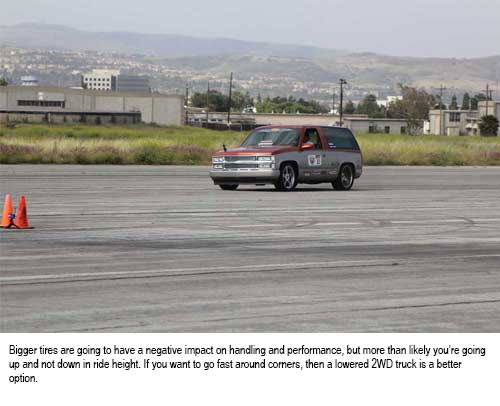
Tire Size and Lift Height
“I want to put an X lift my Y truck, will Z tires fit?” The answer depends primarily on X and Y. Lift kit manufacturers will typically publish a maximum recommended tire size with their suspension products, and you’ll find that most of the time these maximum recommended tire sizes will be pretty consistent among the different suspension brands for equal amounts of lift. Keep in mind that these maximum recommended sizes assume absolutely no modifications to the wheel wells. This is why recommended tire sizes tend to be on the mild end of the spectrum. If you don’t mind a little trimming, you can sometimes go a size or even two higher. Not everyone likes the idea of cutting on their new $60,000+ truck, so be sure you’re not squeamish about fender modifications if you choose to push the envelope on tire size. Tire fitment is further complicated by the wheelwell shape on some trucks. For whatever reason, the last two generations of Chevy trucks have come with tall but narrow fender openings, so they have plenty of height to clear larger tires, but they lack the width. Fords have a similar but less severe problem, while Dodge trucks thankfully don’t have this issue.
One more fly in the ointment on tire fitment is wheel offset or backspacing. This refers to the wheel mounting surface in relation to the location of the inner wheel lip where the tire bead seats. The backspacing of a wheel determines how deep or shallow the tire is positioned in the wheelwell, which can have a profound impact on a tire that clears versus one that hits when turning. Backspacing will also impact whether or not a wheel clears all of the front suspension and brake components. This is especially true on lifted trucks equipped with independent front suspension (IFS). IFS lifts typically include new steering knuckles (spindles) that are taller and have a different profile from the factory knuckles, therefore requiring wheels with shallower backspacing than the factory wheels in order to clear them. On these applications lift manufacturers will usually specify a maximum wheel backspacing in addition to a maximum tire size. To make things even more confusing, wheel offset or backspacing is often expressed one of two ways. When expressed in millimeters, such as +5mm, it is the number of millimeters from the center of the wheel. A positive number indicates a deeper offset (wheel pushed further into the wheel well), while a negative number indicated a shallower offset (wheel sticking out of the wheel well. When expressed as a fraction, such as 4-5/8”, the number indicates the distance between the wheel mounting face and the inner bead lip. The higher the number, the deeper the offset.
In Closing
So there you have it: after this long discussion we’re no closer to determining our top recommendation for your specific application than we were when we started. But perhaps now you have a better understanding as to why, and what you should be considering when tire shopping for your truck. We are fortunate to have an amazing selection of tires for our trucks that range from mild to wild, but there are way more factors to consider than just what will physically fit. We’re still happy to give our recommendations, of course, as all of our customer service guys are enthusiasts just like you. Just be prepared for a lot of questions and have the answers ready if you want our best recommendations.
To check out what products we have available to best complement your truck and tire choice, don’t hesitate to give us a ring by calling (888) 99-DIESEL or look us up at www.dieselpowerproducts.com.
Written By: Trent McGee

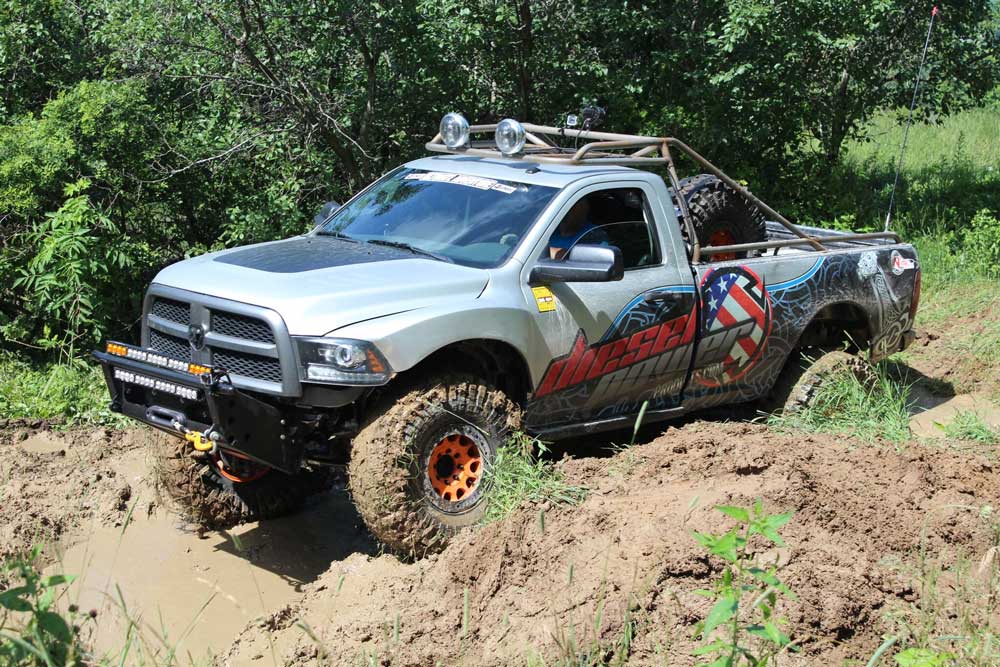
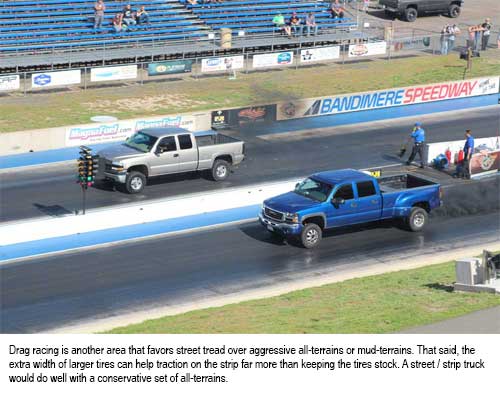
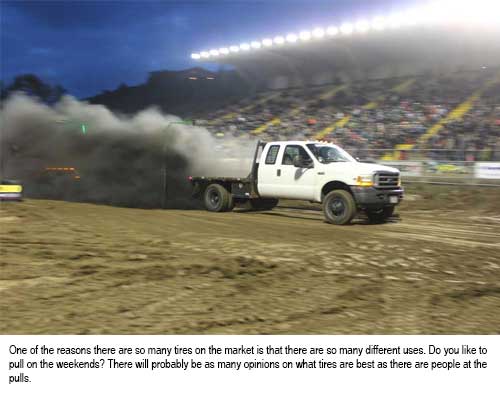
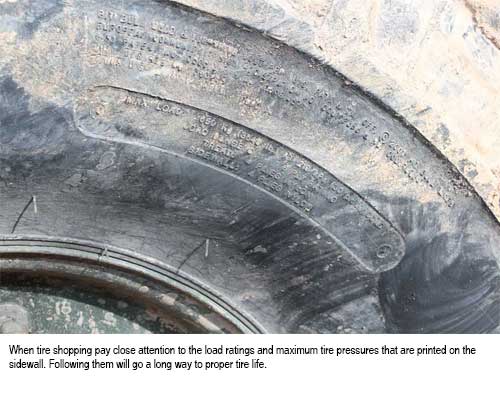
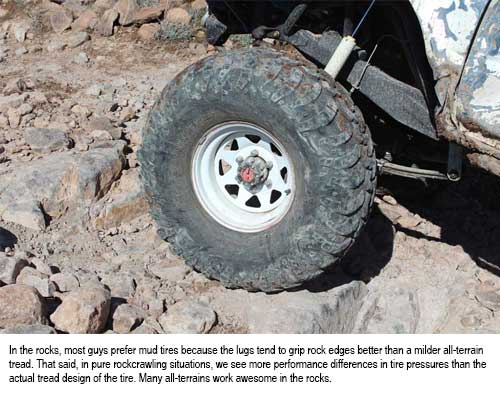
I like what this article mentions about mud terrain tires being one that a lot of truck owners want. It makes sense that they’d provide and aggressive, intense look for the vehicle. It’s something I’ll have to remember but I need some good tires that will work well for where I’ll be driving and I don’t think there will be much mud compared to snow.
Very informative post. I really liked each and every points explained about the tires. Hoping to see some more informative posts from you in coming days.
I like the above mention article. Each and every point of the article clearly explain the tires. I hope to read this type of article from you in the future. stay home and stay safe